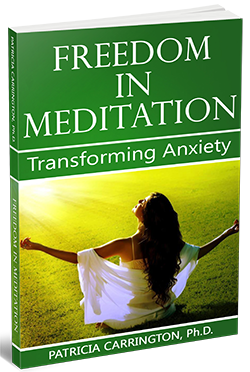The Mystery of the Mantra
Patricia Carrington, Ph.D.
Author of “The Book of Meditation”
This kind of consideration leads to the possibility of some interesting experimentation. We could, for example, make predictions on the basis of what we have so far informally observed about the response to different sounds using Benson’s method. One such prediction might run as follows: ‘For most people repeating the sound ‘‘one’’ is more soothing than repeating the sound ‘‘two’’.’ Then, in scientific fashion, we could proceed to test this assumption, an elaboration of the experiment you have just performed for yourself.
At Princeton, researcher Douglas Moltz and I set out to investigate the effects of word sounds on mood in a more formal way.1 We began with the simplest component of words – single syllables without specific identifiable meanings in English – sounds such as ‘wys’, ‘grik’, ‘rahm’, ‘noi’, and others. From a large pool of such nonsense syllables, a group of colleagues selected five sounds which seemed to them to be extremely ‘soothing’; another five which seemed extremely ‘jarring’; and five more which seemed neutral in their effects. Their choices were used to construct a list of fifteen nonsense syllables.
Our next step was to present this list to 100 college student volunteers and have them mentally repeat each one of the fifteen sounds and rate them on a seven-point scale from ‘extremely soothing’ to ‘extremely jarring’. When we studied their ratings we found there was a remarkable agreement among these subjects.
For example, the same two sounds were rated as ‘soothing’ by the overwhelming majority of subjects, with only three raters out of the 100 reporting a negative reaction to them. Likewise, the two sounds that were rated as ‘jarring’ were experienced as unpleasant so often that only two subjects out of the 100 had any positive feelings about them. One other sound was rated as ‘neutral’ most of the time. We were thus easily able to identify three sounds that had received very strong ratings.
We next asked another group of volunteers to repeat each of these three sounds silently in their minds for five minutes, and then to fill out an adjective checklist describing what their mood was like during the time they had been mentally repeating each sound. We wanted to see if certain word sounds would have different and specific effects on mood. This was an indirect way of testing the claim of the meditative traditions that particular mantras have particular effects.
We had guessed that some of the sounds might be more soothing than others but were unprepared for the dramatic results found. The experiment showed that moods can change in surprisingly specific ways according to the word sound the person is thinking.
For example, only one sound (‘Lom’) caused anger and hostility to be lowered in our subjects, while another sound (‘grik’) caused an angry, irritable mood to increase significantly. Repeating the harsh sound ‘grik’ also lowered depression (perhaps because it released anger), and the sound ‘Lom’ decreased ‘sluggish’ feelings. The sound ‘noi’ lessened feelings of being ‘worn out’ (a fatigue-related state), while ‘grik’ had no effect on either fatigue or inertia. ‘Noi’ was the only one of the three sounds that decreased tension and anxiety, but all the sounds reduced feelings of ‘vigor’ and ‘activity’, perhaps because repeating any sound long enough slows people down.
These results made it seem quite plausible that different mantras could be used selectively for lightening depressions; soothing an irritated patient; counteracting fatigue; lowering anxiety; releasing creativity; increasing energy; or for any number of other purposes. In fact, specific assignment of mantras to obtain special effects to suit individual needs has been practiced for thousands of years by masters working with the ancient meditative traditions, with claims of remarkable success. Since a suitable means of matching a specific mantra to a particular trainee has not yet been developed on a scientific basis, however, in its absence, our own inner wisdom as to which sounds ‘feel’ right to us to repeat mentally seems our best guide when undertaking any method of meditation without the assistance of a highly experienced meditation teacher.
Such self-selection of mantras can, in fact, work. At the New York Telephone Company the Clinically Standardized Meditation (CSM) method was used to train nearly 5,000 employees (see Chapter 18). A careful follow-up by the company revealed that all those who had learned the method were comfortable with the mantras they themselves had chosen – there was not a single report of adverse effects from repeating these mantras. This does not mean, of course, that a mantra assigned to a pupil by a master of the meditative traditions may not be more profound in its effects than one which a person might select for himself, but in the absence of a highly experienced meditation teacher, the latter seems the safest route to follow.
Margaret’s experience illustrates this point. This woman, a stranger to me, had read my first book on meditation and had telephoned me seeking my advice for what she described as an urgent problem concerning meditation. She told me that she had been assigned a mantra by a meditation organization that had assured her it was ‘exactly the right one’ for her, although she said she had disliked it intensely from the beginning. Eventually she had had to abandon her meditation practice entirely because of the discomfort that thinking this mantra caused her.
Because her negative reaction to the mantra was so strong, it seemed to me that the particular mantra she had used might be the cause of her difficulty. The obvious next step was for her to try a new one and I presented her with the list of CSM mantras regularly given to those who learn this method.
At first, Margaret couldn’t comprehend how a sound, which she had repeated only in her mind, could cause so much difficulty, but when I asked her if an irritating tune had ever kept running through her mind even though she didn’t ‘hear’ it played outside, and what effect it had had, she understood my point and was ready to cooperate. She chose a mantra from the list I dictated to her and started using it the following day. As soon as she did so, she was able to resume regular meditation. To her surprise her meditation sessions were now experienced as extremely relaxing, helpful and enjoyable. While her former mantra had been disturbing, her new self-selected one immediately had a calming effect.
It seems, then, as though sounds may have very specialized effects on people who repeat them, even when they are not pronounced out loud but only ‘thought’. If the results of this experiment are borne out by future studies, it is possible that some day we may be able to predict accurately the effects of sounds on moods – something which could be very useful for therapeutic purposes. Conceivably different mantras might then be used selectively for lightening depressions; soothing an irritated patient; counteracting fatigue; lowering anxiety; releasing creativity; increasing energy; or for any number of other purposes. Specific assignment of mantras to obtain special effects to suit individual needs has been practiced for thousands of years by masters working with the ancient meditative traditions, with claims of remarkable success. Perhaps we are on the verge of being able to apply this ancient art of the guru in a scientific manner on the basis of laboratory experimentation.
If future studies show that simple nonsense syllables have specific effects on mood, then researchers may want to go a step further and design experiments to find out whether some of the traditional mantras, particularly the renowned Sanskrit mantras whose long-term effects can be predicted, are more effective for certain purposes than other, more ‘prosaic’ everyday sounds. This may well be the case, because these ancient mantras were selected and refined through a trial-and error process lasting for thousands of years.
If we were to find that Sanskrit and other ancient mantras are indeed more effective than ordinary English words for certain purposes, we can visualize researchers working to identify the particular consonants and vowels and the combinations of these, or the particular pitch and length of beat, which gives the mantra the effect it has. Only through experiments such as these will we be in a position to make fully effective use of mantra meditation on a scientific basis. In the interim, we will have to resort to what is largely a trial-and-error process in assigning mantras to individuals, and must be alert to the reaction of each person to the particular mantra assigned to her – or which she has chosen, as the case may be.
The choice of the mantra certainly need not be a mysterious or secret process. On the basis of our study on the effects of sound on mood, and my own experience teaching meditation, it would seem that there are some objective criteria which can be applied in selecting a mantra, and I would strongly doubt that there is any such thing as the ‘right’ mantra for any one person. Our work suggests that there are more likely to be a number of different mantras which can be beneficial for each person and that the one which is finally chosen may need to be determined by the specific changes that the person seeks to bring about in herself. There are also likely to be a number of mantras which might be more neutral in their effects on the same individual, and still others which might be irritating or possibly even detrimental to her.
There are a few precautions which need to be observed when selecting your mantra, however. Certain mantras are what are technically known to Yoga practitioners as bija mantras. These are extremely powerful sounds which are thought to be unsafe for those whose nervous systems are not properly prepared for them, and to produce undesirable effects such as confusion, delusions, hallucinations or other symptoms of mental illness if they are not handled expertly. As a precaution I have eliminated all bija mantras from the list of mantras presented to people learning my CSM system, and I suggest that anyone who plans to self-select their own mantra – unless they are using the CSM recorded training which automatically takes care of the problem – check first with an experienced meditation teacher to be certain that the sound they have chosen is a safe one. Properly used, a suitable mantra can bring about deep positive experiences that can enhance both physical and mental health, but the latent power inherent in the mantra must be respected.
1. D. Moltz, ‘Effects of Internally Generated Sounds on Mood’ (senior thesis, Princeton University, 1976).
Learn about Clinically Standardized Meditation
A Gentle, Easy-to-Learn, Form of MeditationClinically Standardized Meditation (CSM) is a clinically sensitive meditation method used by numerous medical institutions, organizations, and individuals worldwide.








